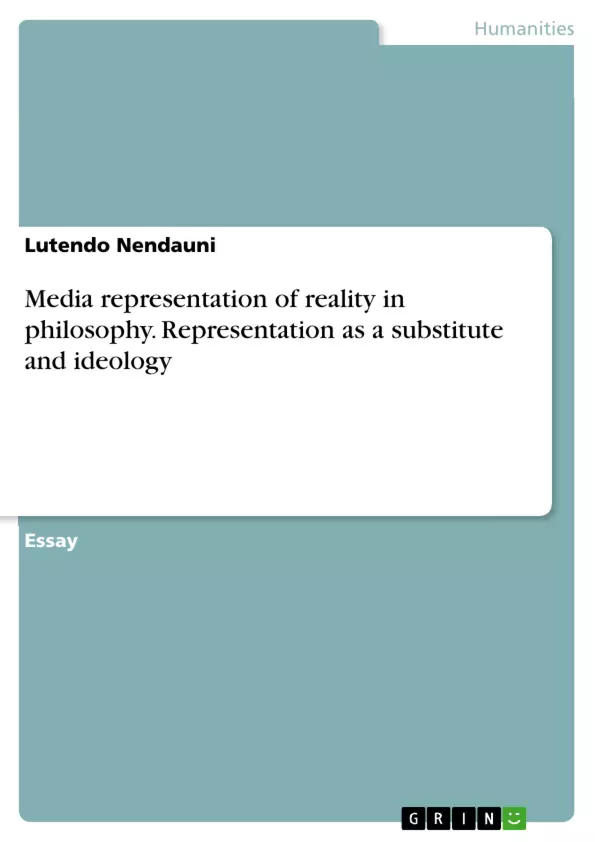This essay seeks to critically discuss the concept of representation in media discipline as well as to examine how different media scholars view the concept of representation.
Representation is simply the act of imitation or the act of identification, people identify themselves by means of their mimetic ability, when they see themselves in others and perceive a state of mutual equality. Representation of reality may refer to simile, similarity and symbolization of the world when we take it as a transformation of myth.
The idea of representation at its simple level involves our understanding for the action of representation and how we define that act. This essay details media representation of reality as outlined by key theorists and their theories in the classical age and it further explains representation as a substitute and also as ideology.
Classical age refers to the antique period before the birth of Jesus Christ. Key philosophers during this period included people such as Plato who is the ancient Greek philosopher; Aristotle who is also a Greek philosopher and he was Plato’s student; Saint Thomas Aquinas who is a theologian from Italy; Galileo Galilei an Italian physician, astronomy and philosopher and last but not least Francis Bacon who is an English philosopher and leader of scientific revolution. I will critically do an in-depth analysis/discuss representation as outlined by this philosophers and I will also distinguish representation as a substitute and ideology.
Inhaltsverzeichnis (Table of Contents)
- INTRODUCTION
- CONCLUSION
- REFERENCE
Zielsetzung und Themenschwerpunkte (Objectives and Key Themes)
This essay aims to analyze media representation of reality as depicted by key theorists of the classical age. It examines representation as both a substitute and an ideology, exploring the perspectives of influential philosophers such as Plato, Aristotle, Aquinas, Galileo, and Bacon.
- The concept of representation in classical philosophy
- Representation as imitation (mimesis)
- Representation as a sign or symbol
- The ethical and epistemological implications of representation
- Representation as a scientific indicator and ideology
Zusammenfassung der Kapitel (Chapter Summaries)
INTRODUCTION: This chapter introduces the concept of representation, defining it as the act of imitation or identification. It establishes the context of the essay, focusing on media representation of reality as interpreted by key classical-age theorists. The chapter also introduces the concept of representation as a substitute and as an ideology, setting the stage for a deeper exploration of these perspectives in subsequent sections.
Schlüsselwörter (Keywords)
Media representation, classical philosophy, Plato, Aristotle, Aquinas, Galileo, Bacon, mimesis, ideology, substitute, imitation, sign, symbol, ethics, epistemology, scientific indicator.
Frequently Asked Questions: A Comprehensive Language Preview
What is the purpose of this document?
This document provides a comprehensive preview of a larger work, offering a structured overview of its contents. It includes the table of contents, objectives and key themes, chapter summaries, and keywords.
What topics are covered in this work?
The work focuses on the analysis of media representation of reality as viewed through the lens of classical philosophy. It explores the concept of representation as both a substitute for reality and as an ideology, examining the perspectives of influential classical thinkers such as Plato, Aristotle, Aquinas, Galileo, and Bacon.
What are the key themes explored?
Key themes include the concept of representation in classical philosophy; representation as imitation (mimesis); representation as a sign or symbol; the ethical and epistemological implications of representation; and representation as a scientific indicator and ideology.
Which classical philosophers are discussed?
The work analyzes the views of Plato, Aristotle, Aquinas, Galileo, and Bacon on representation and its implications.
What is included in the introduction chapter?
The introduction defines representation as the act of imitation or identification, establishes the context of the essay, focuses on media representation of reality as interpreted by classical theorists, and introduces the concepts of representation as a substitute and as an ideology.
What are the key words associated with this work?
Key words include: Media representation, classical philosophy, Plato, Aristotle, Aquinas, Galileo, Bacon, mimesis, ideology, substitute, imitation, sign, symbol, ethics, epistemology, scientific indicator.
What is the structure of the document preview?
The preview is structured to provide a concise overview. It includes a table of contents, a detailed description of the objectives and key themes, summaries of the chapters (at least the introduction), and a list of keywords.
What is the intended audience for this preview?
The intended audience is likely academics or students interested in the intersection of classical philosophy, media studies, and representation theory.
- Citar trabajo
- Lutendo Nendauni (Autor), 2016, Media representation of reality in philosophy. Representation as a substitute and ideology, Múnich, GRIN Verlag, https://www.grin.com/document/344557



